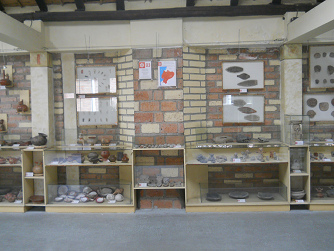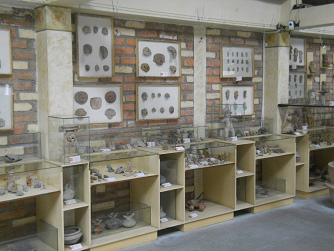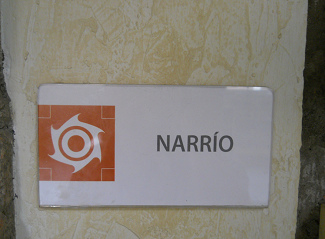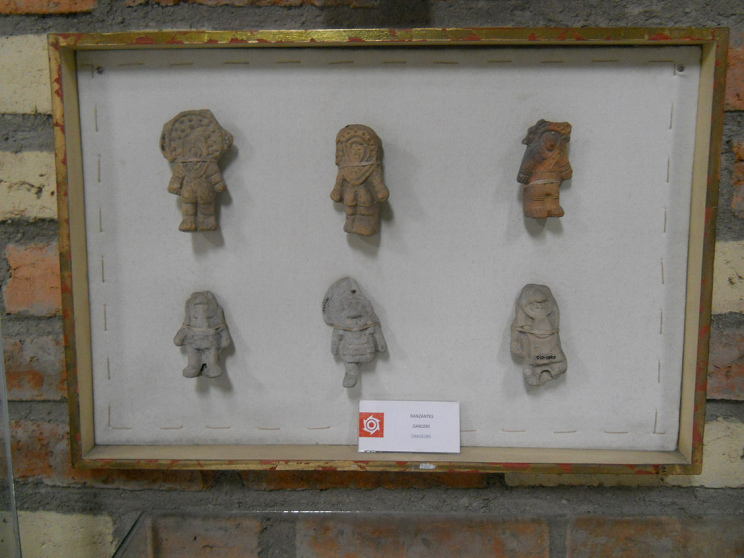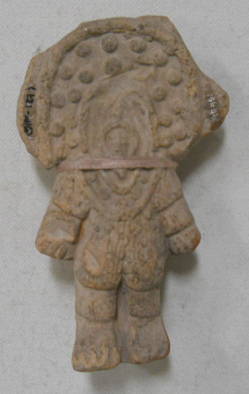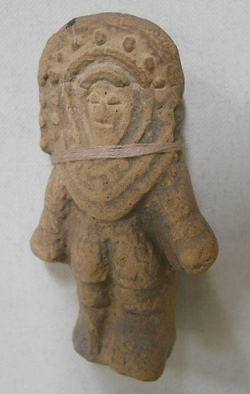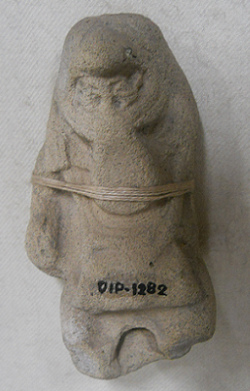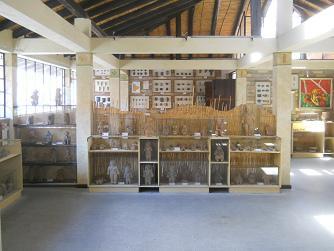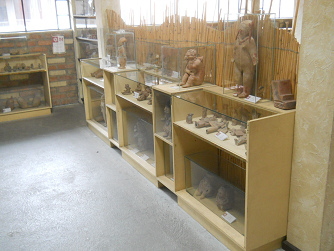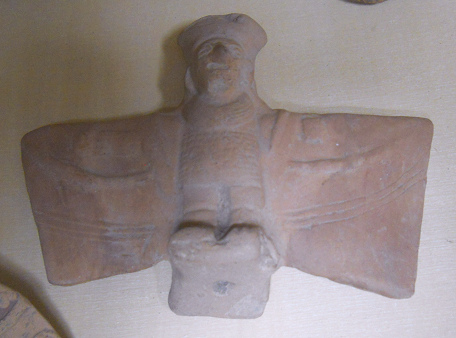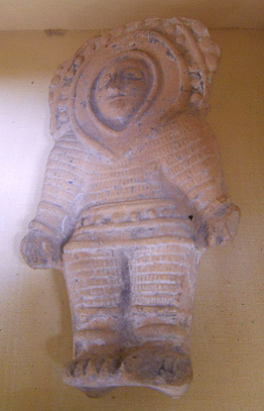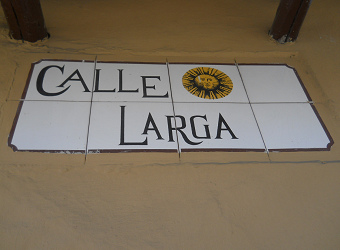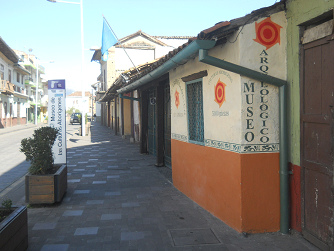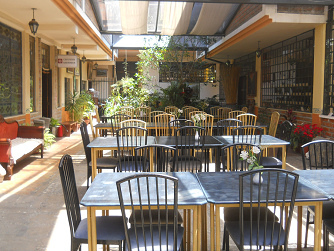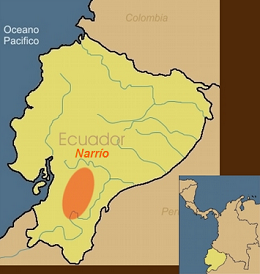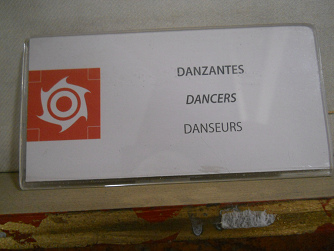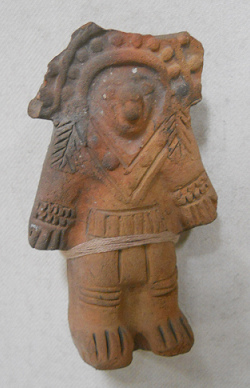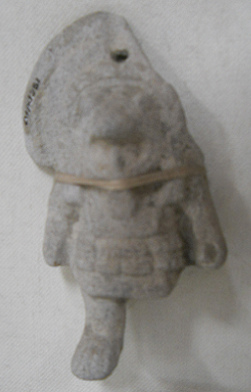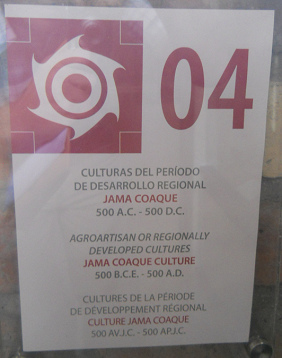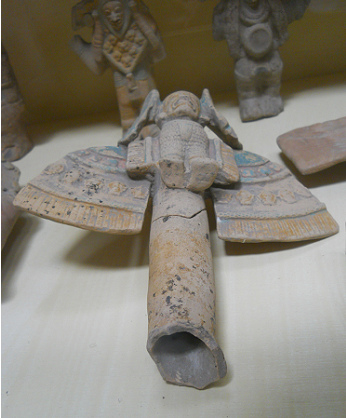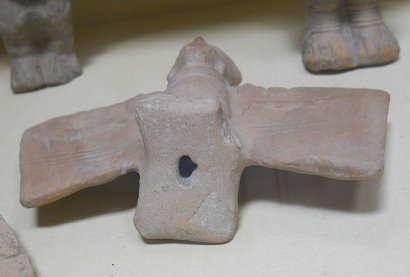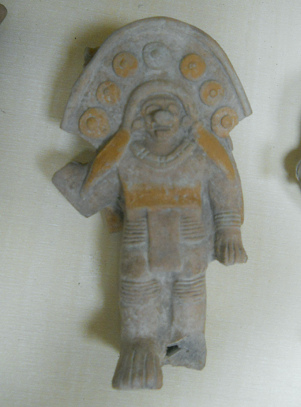The town of Cuenca in Ecuador - father Crespi with
collections, schools, entertainment and Crespi Museum
My motivation in 2012 to go to Cuenca was to see the Crespi
Museum which was described in books by Erich von Däniken.
Cuenca is a town in southern Ecuador with 277,000 people on
about 2,550 m of height in Azuay Province. The center of
Cuenca is full of houses in an old colonial style and is a
world heritage of UNESCO. Tomebamba River is passing the
town [web01]. For goodness sake Cuenca did not suffer bigger
earthquakes (yet) and therefore the center is almost
complete - and well maintained.
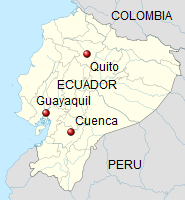
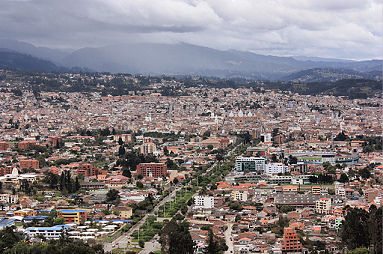

Map of Ecuador with Quito, Guayaquil and Cuenca [1] -
aerial photo of Cuenca [2] - row of houses in the center
of Cuenca [3]
Cuenca has a strong European cultural
tradition, among others taught by father Crespi who died
in 1982 (here is a
Crespi
chronology). Crespi is a brilliant model who
helped the poor, was organizing collections and
entertainment for youth and for young adults, he was
organizing schools and education (Colegio Salesiano) and
he had a museum (Museo Crespi) with objects which were
given to him from the natives. People who had passed
this Salesian College with Crespi had a strong and
constructive spirit - and this constructive spirit can
be seen in Cuenca at almost any corner - with the
exception of the loud buses disturbing the atmosphere -
as if there would not exist quiet buses in the world.
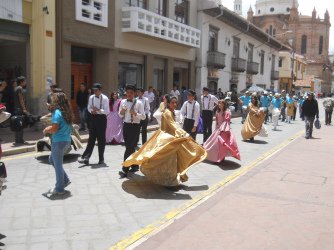
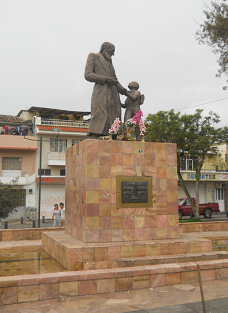

Procession in Cuenca [4] - Crespi monument in Cuenca [5] -
All Saints Bridge (puente Todos Santos) in Cuenca passing
Tomebamba river [6]
When Crespi died in 1982 the Crespi Museum was dissolved,
parted and partially plundered as my search in 2012
indicated. UNESCO was defining the center of Cuenca as a
world heritage in the same year of 1982 but the Crespi
Museum was not protected (!). In other words: the mentality
of some responsibles in Ecuador seems not so "maintained"
unfortunately like the center of the town. The chance to
install a big Crespi Museum as an attraction for Ecuador and
the whole world was missed. The metal relief plates
(Láminas) which are described in some books of Erich von
Däniken were scattered to all possible private households
(estate 2012), as a speculation object as it seems. Nobody
of the responsibles in the Salesian College or of the
museum's management in the Central Bank wanted to tell me
where the "Láminas" are today (2012). The reliefs telling
history of former times seem to be absolutely not important
for the responsibles. And when I was asking more then the
people got distrustful.
Not only the golden and silver relief plates had gone but
also many paintings of the Crespi collection had gone: First
they were handed from the Salesian responsibles to the
Central Bank of Cuenca (Banco Central) for administrating
this treasure. But the responsibles of this Central Bank let
"vanish" these paintings step by step selling them secretly
or distributing the painting to "representative" locations
in the whole country. Only a little part of the paintings
can be seen in the bank of "Banco Central" in Cuenca yet but
taking photos is forbidden and there are no picture
postcards either.
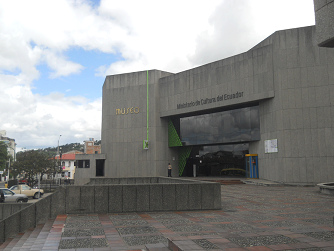
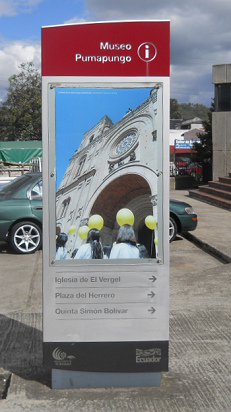
The Central Bank's Museum (Museo dl Banco Central) in
Cuenca [7] - the mark of "Museo Pumapungo", another name
for the Central Bank's Museum [8]
"Puma pungo" is Ecuadorian Quechua meaning "Puma's
Bridge".
This Central Bank in Cuenca has installed an own
Ethnological Museum ("Museo de la Cultura", "Museo
Pumapungo") which is know also - as "Central Bank's Museum"
("museo del Banco Central"). There are the colored ceramics
and clothes and rites of the natives of Ecuador but no
photos were allowed. Museum's police is following the
visitor so no photo was possible. This is really a pity
because there were no picture cards or books either of the
objects. There is missing just something about tourism and
education management - in this Central Bank. Without photos
or books any research is blocked and no comparison with
other cultures are possible.
Well, only in the outer area of the Bank's Ethnological
Museum photos were allowed where passed towns were
described. On a wooden board with a description of the
passed town of Tumipampa an extraterrestrial was catching my
eye, just burned into the wood. This figure I had seen on a
ceramic in the Bank's Museum already (but no photos were
allowed). On the board there was this extraterrestrial (an
angel or a giant) just in an unremarkable way left above -
with a triangle head, a rectangular trunk, big wings,
antennas on the head, a scepter as big as the
extraterrestrial himself - this was just a little greeting
what could be found in Cuenca with extraterrestrials yet.
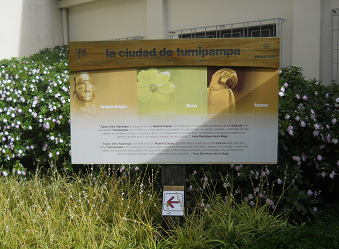

Board with the description of the passed town of Tumipampa
[9] - extraterrestrial with wings, antennas and triangular
head on the board of the passed town of Tumipampa [10]
There were more objects collected by father Crespi like
colorless ceramics. It seems that the banksters in Ecuador
considered them as without value. Thus the colorless
ceramics were not distributed or sold, but a Native Museum
("Museo de los Aborígenes") was installed with it at Calle
Larga (Long Street) just aside of Tomebamba River at the
border of the center of the town being managed by a
foundation. The banksters of the Central Bank - without any
history knowledge - do not see the value of colorless
figurines. The foundation is administrating this
archaeological treasury preserving the recording of the
past.
Additionally the winged lion from the museum's logo could
not be verified in the museum itself. There is nowhere any
winged lion in the museum. It seems that it was only copied
from Asia somewhere.
Well, this Native Museum is a paradise for pre astronautics
with about one dozen or more astronauts and hundreds of
mixed beings and fabulous animals which are nowhere
described in any travel guide. The museum is defining the
statues and figurines simply as "anthropomorph" (similar to
humans) or "zoomorph" (similar to animals), or astronauts
are also called "dancers". Well, vain NASA will have to
learn something, and in all history encyclopedias some pages
about early history are missing.
At the counter an e-mail museoculturasaborigenes@hotmail.com
was indicated. Looking for this e-mail in the Internet I
landed on a web site of the museum in Spanish:
http://museoculturasaborigenes.com/.
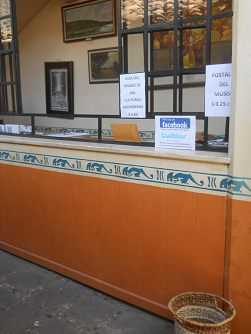
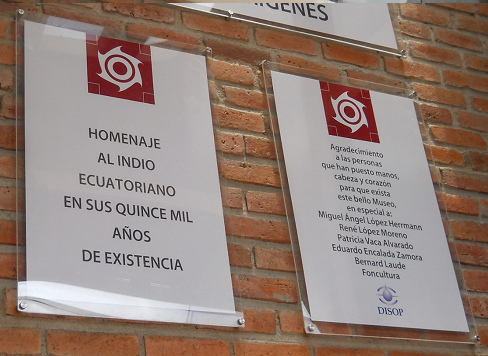
The counter of the Native Museum (Museo de los Aborígenes)
in Cuenca in Ecuador [20] - the dedications and
thanksgivings [21]
As already mentioned the astronauts are only called
"anthropomorphic" or "zoomorphic" beings or "dancers". In
this way the passed cultures are systematically degraded.
Unfortunately "good Christians" in Ecuador are very
conservative yet until today and they are stubborn until
they die also when the astronauts are "presenting"
themselves to them in real - and the pastors and bishops of
Ecuador are not giving in (until today) simply because they
mean that an interpretation as "astronauts" would just be
one of the "interpretations".
Well, in the second floor - there they are - the astronauts
of early times of pre astronautics! How long wants the
Catholic Church deny this yet?
Chorrera culture (1,500-300 BC. appr.) with astronauts
The Chorrera culture was in the today's provinces of Guayas,
Los Ríos, Manabí and Esmeraldas in the lower parts of
today's Ecuador [web07].
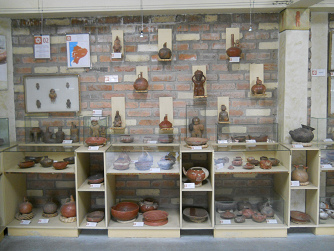
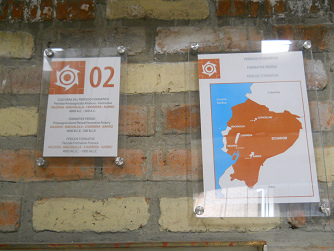
Section with Chorrera culture [22] - the text of the
museum indicates in general all early cultures Valdivia -
Machalilla - Chorrera - Narrío 4,000-500 B.C. [23]
For the Chorrera culture different
data are indicated: The museum is not indicating
anything special. Wikipedia indicates 1,300-300 B.C.
[web02], Antje Baumann on her native works
(www.indianerwelt.de) indicates 1,200-500 B.C. [web03],
an Ecuadorian web site indicates 1,500-500 B.C. [web07]
and a French web site indicates 1,800-500 B.C. [web10].
Precise research is needed indeed.
![The map of the museum of the
cultures Narrío, Valdivia, Chorrera, Machalilla and
Cotocollao in today's Ecuador (Valdivia was 2,000
years before Chorrera [web12]) The map of the museum of the cultures Narrío,
Valdivia, Chorrera, Machalilla and Cotocollao in
today's Ecuador (Valdivia was 2,000 years before
Chorrera [web12])](mus-ur-astronauten-d/024-karte-kulturen-Chorrera-Valdivia-Narrio-Machalilla-Cotocollao.png)

The map of the museum of the cultures Narrío, Valdivia,
Chorrera, Machalilla and Cotocollao in today's Ecuador
(Valdivia was 2,000 years before Chorrera [web12]) [24] -
and there is a map with Chorrera culture in the lower
parts of today's Ecuador [map 1].
The astronauts of Chorrera culture are clearly visible.
Very characteristic are helmets, smooth space suits and
foregoing long slit eyes which are much longer than the
mouth is, and characteristic is also the compact body
with a head as big as the complete chest and lung area.
The arms only reach the hips and the legs are very
short. Additionally the neck is missing. But it seems
that these extraterrestrials with helmets and slit eyes,
short arms and legs had a certain importance because the
natives themselves never presented themselves in such an
impressive way:
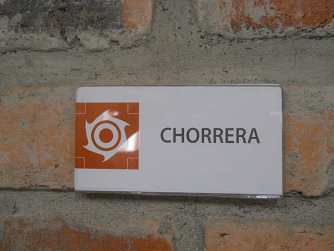

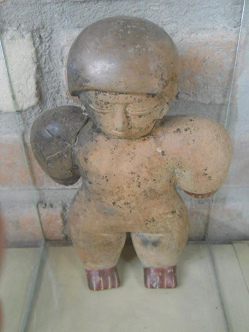

The tab of Chorrera culture [25] - big astronauts of
Chorrera culture [26+27], and all this should be
"anthropomorphe" sculptures ("similar to humans"), more is
not allowed to say in this Catholic museum... [28]
Well, in Quito in the Archaeological Museum (Museo
Arqueológico) in the House of Cultures ("Casa de la
Cultura") are seven more such astronauts, two of them
sitting in an Indian style - in the show cases about
Chorrera culture.
Narrío culture (2,000-600 B.C. appr. [web04]) with
astronauts
Narrío culture was concentrating around Narrío Mountain in
southern Ecuador in the high Sierra [web08]. The population
was existing from 2,000-600 B.C. according to ecuatur.com
[web04]. The web site of viajandox.com indicates a general
population of the Narrío Mountain with 2,500 B.C. until
1,532 D.C. [web09].
Jama-Coaque culture (500 B.C.-500 D.C. appr.) with
astronauts and flying gods (extraterrestrials)
The museum indicates for Jama Coaque culture 500 B.C. to 500
D.C. Other sources (culturase) indicate 500 B.C. to 1,531
D.C. [web05], or the video "Cultura Jamma Coaque" indicates
500 B.C. to 1,500 D.C. [web06], or the archaeological web
site of guangala.com indicates 200 B.C. to 800 D.C. [web11].
Well, there seems to be some need of research.
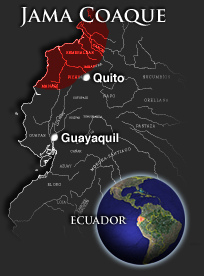

Map of Jama Coaque culture (today's provinces of
Esmeraldas and Manabí) [maps 3+4]
The settling area of the Jama Coaque culture was along the
coast line of today's provinces of Esmeraldas and Manabí. In
the video (cit.) the figurines and little statues are
described as a great "art's treasury" [web06]. Well, there
are astronauts and even flying extraterrestrials - one even
with wings on his ears - it's just more than art.
And imagine: In the Archaeological Museum (Museo
Arqueológico) in Quito in the "Casa de la Cultura" one can
find further such astronauts and one more winged god - in
the show cases about Jama Coaque culture.
Big questions to the research: names? function?
parallels? gold and silver plates with reliefs about old
history of Ecuador?
Considering these astronauts of different old cultures of
Ecuador in just one single museum there is just one
conclusion first: The historic research has failed
completely until today. Since Crespi these figurines are
publicly accessible and research is practically not
existing. Also when a dancer has got a space suit as we know
from NASA this figure is called only a "dancer" in the
museum and not as an astronaut. Well, some time this
hide-and-seek of the church and of NASA will have an end.
When the astronauts will be called as what they are? Stone
Age was just not only a "Stone Age", and "old cultures" were
just not only agriculture but astronauts came from time to
time from other solar system from other stars. And with this
new questions are coming up:
Are the astronauts and their stars of origin somewhere
prescribed in the artifacts or in scriptures or in
paintings?
Are there pictures or paintings with space ships in Ecuador?
How are the extraterrestrials of the Ecuadorian cultures
called? What was their function? What did the
extraterrestrial teachers teach to the cultures?
Are there parallels to the cultures of Central Asia or
Egypt?
And the golden and silver relief plates from the Crespi
museum are missing. Are these "Láminas" recollected
sometimes so the motives about old Ecuadorian history can be
contemplated and studied?
One should not let go archeology and arts only to a bank.
But the banksters were so blind at least that they did not
see the astronauts and did not sell them.
And in the history encyclopedia there are really missing
some pages about early history so...

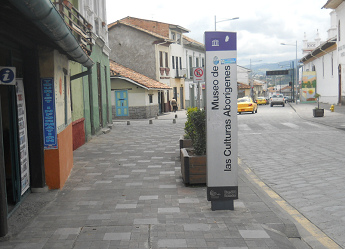
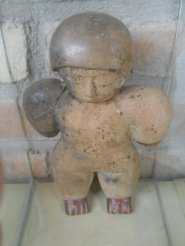
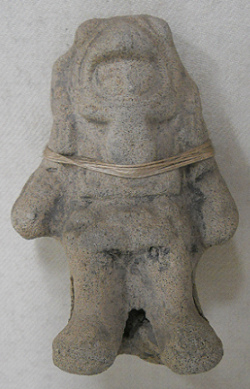







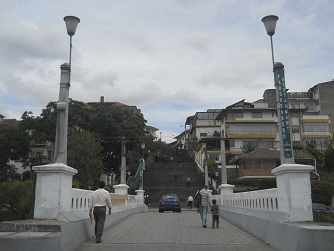
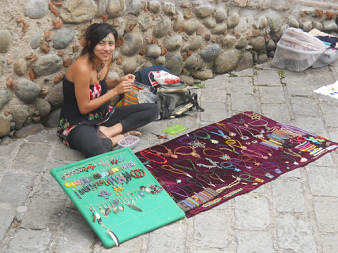
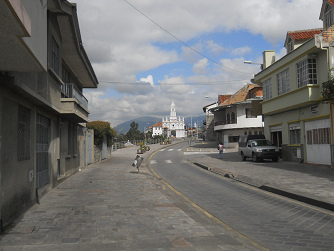

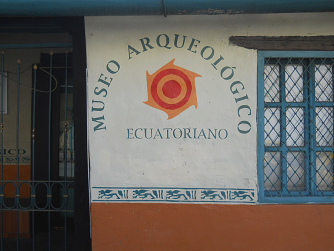
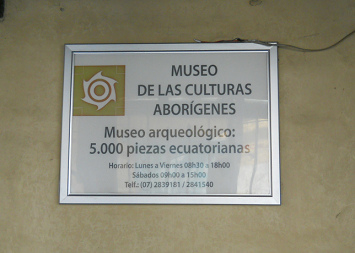



![The map of the museum of the
cultures Narrío, Valdivia, Chorrera, Machalilla and
Cotocollao in today's Ecuador (Valdivia was 2,000
years before Chorrera [web12]) The map of the museum of the cultures Narrío,
Valdivia, Chorrera, Machalilla and Cotocollao in
today's Ecuador (Valdivia was 2,000 years before
Chorrera [web12])](mus-ur-astronauten-d/024-karte-kulturen-Chorrera-Valdivia-Narrio-Machalilla-Cotocollao.png)



